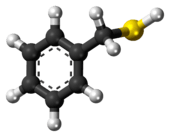Benzyl mercaptan
 | |
 | |
| Names | |
|---|---|
| Preferred IUPAC name
Phenylmethanethiol | |
| Other names
alpha-Toluenethiol Benzylthiol Thiobenzyl alcohol Benzyl mercaptan alpha-Toluolthiol Benzylhydrosulfide Benzyl hydrosulfide | |
| Identifiers | |
| 100-53-8 | |
| 3D model (Jmol) | Interactive image |
| ChEMBL | ChEMBL1224557 |
| ChemSpider | 13851383 |
| ECHA InfoCard | 100.002.602 |
| PubChem | 7509 |
| UNII | OS34A21OBZ |
| |
| |
| Properties | |
| C7H8S | |
| Molar mass | 124.20 g/mol |
| Appearance | colourless liquid |
| Odor | leek or garlic-like |
| Density | 1.058 g/mL |
| Melting point | −30 °C (−22 °F; 243 K) |
| Boiling point | 195 °C (383 °F; 468 K) |
| low | |
| Solubility | very soluble in ethanol, ether soluble in CS2 slightly soluble in CCl4 |
| Refractive index (nD) |
1.5751 (20 °C) |
| Hazards | |
| NFPA 704 | |
| Flash point | 70 °C (158 °F; 343 K) |
| Lethal dose or concentration (LD, LC): | |
| LD50 (median dose) |
493 mg/kg (rat, oral) |
| Except where otherwise noted, data are given for materials in their standard state (at 25 °C [77 °F], 100 kPa). | |
| | |
| Infobox references | |
Benzyl mercaptan is an organosulfur compound with the formula C6H5CH2SH. It is a common laboratory alkylthiol and occurs in trace amounts naturally. Condensed tannins can undergo acid-catalyzed cleavage in the presence of the nucleophilic benzyl mercaptan. Benzyl mercaptan has been identified in boxwood (Buxus sempervirens L.) and is known to contribute to the smoky aroma of certain wines.[1] It also occurs naturally in coffee.
It is created by the reaction of benzyl chloride and sodium hydrosulfide.
Use in organic synthesis
The compound is used as a source of the thiol functional group in organic synthesis. It is introduced by S-alkylation to give alkyl benzylthioethers. Debenzylation is effected by dissolving metal reduction, which attacks the weakened S-benzyl bond:[2]
- RSCH2C6H5 + 2 "H" → RSH + CH3C6H5
Methoxy-substituted derivatives of benzyl mercaptan have been developed that cleave easily, are recyclable, and are odourless.[3]
References
- ↑ Contribution of benzenemethanethiol to smoky aroma of certain Vitis vinifera L. wines. Tominaga, Takatoshi; Guimbertau, Guy; Dubourdieu, Denis, 2003
- ↑ Norman Kharasch and Robert B. Langford (1973). "2,4-dinitro-Benzenesulfenyl chloride". Org. Synth.; Coll. Vol., 5, p. 474
- ↑ M. Matoba, T. Kajimoto, M. Node "Development of a Novel Benzyl Mercaptan as a Recyclable Odorless Substitute of Hydrogen Sulfide" Synlett 2007, pp. 1930-4. doi:10.1055/s-2007-984524
